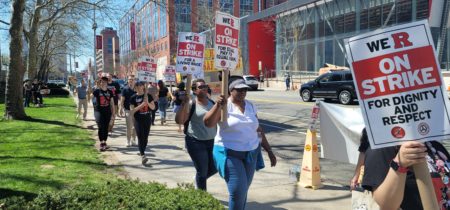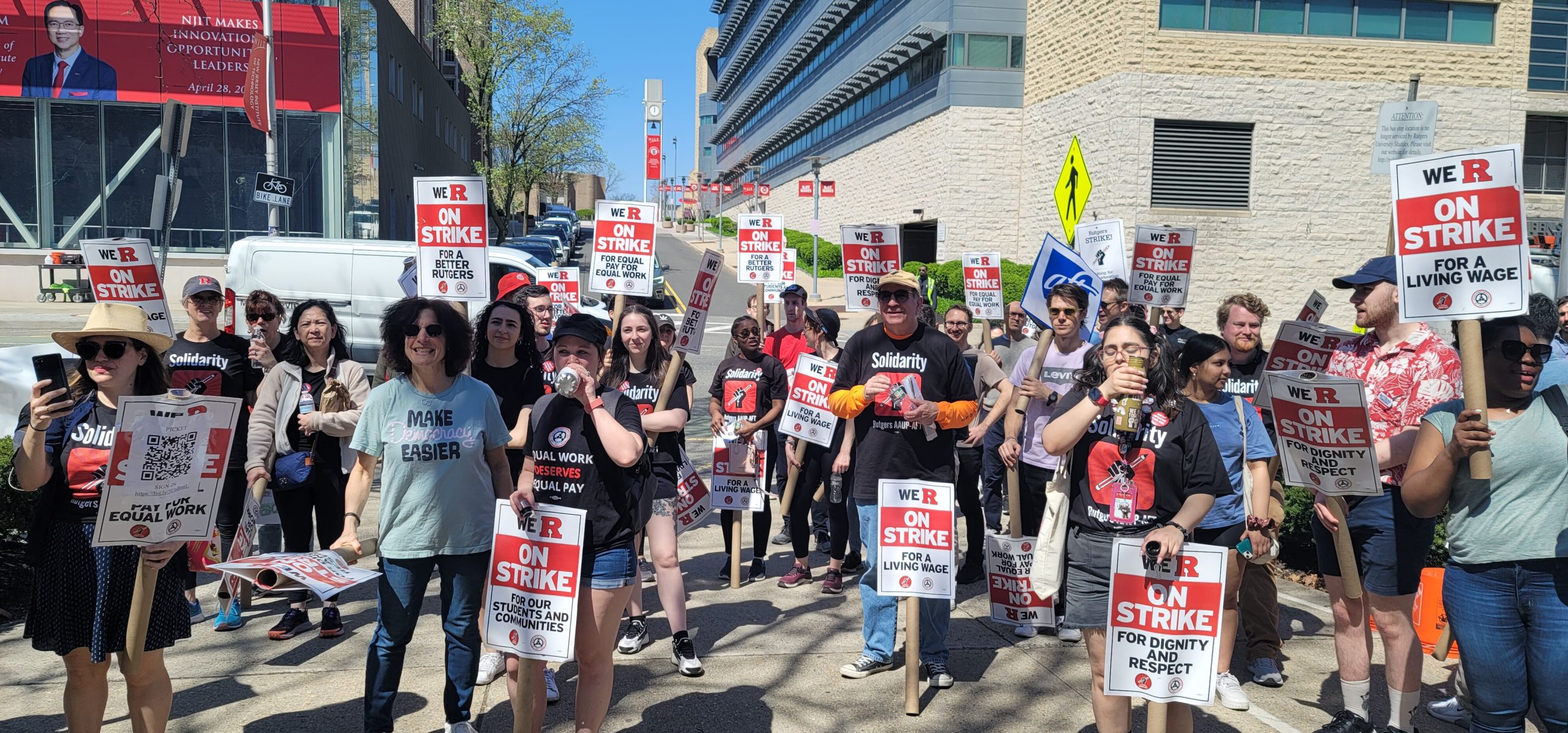Story By Walter Elliott
Photos Courtesy Charles Hall
NEWARK – There were picketers walking their beat here at Rutgers-Newark April 12 before their representatives had resumed negotiations with Rutgers University administrators at 10 a.m. in Trenton’s State House.
Members of the three striking unions – representing full-time and part-time faculty, graduate students, counselors and medical and public health teachers – began walking in a circle before Rutgers-Newark’s Paul Robeson Student Center’s Dr. Martin Luther King, Jr. Boulevard entrance at 9:20 a.m. Wednesday.
The Rutgers-Newark campus there at that hour was otherwise unusually quiet for mid-Spring. It had more of an early August feel, when facilities workers make repairs after the Summer session and before pre-Labor Day arriving students.
The student center itself, 110 Warren Street (formerly Bradley Hall) and the Dana Library were open. There was a student desk attendant here or there, campus police making their usual rounds and a student or two.
A rare instructor may make a brief check into his or her office. Classrooms, offices and computer laps, however, were closed.
It was as if most everyone at Rutgers-Newark chose to honor April 9’s strike and April 10 walkout made by members of the American Association of University Professors-AFT, the Rutgers Adjunct Faculty Union and the AAUP-Biomedical and Health Sciences of NJ medical and health instructors here, Rutgers-Camden and the main New Brunswick campus.
A fourth union – the 2,500-strong University of Rutgers Administrators-AFT – may join their 9,000 colleagues from the other three unions as early as press time. (These figures are from all three campuses.)
The first three unions struck Rutgers for the first time in the university’s 253-year history after what they said was 10 months of negotiations without a contractual agreement. They have gone without a new collective bargaining agreement the whole 2022-23 school year so far. (They have been paid on the expired but still honored contract.)
Back at the picket line, many picketers were holding signs whose slogans include “On Strike for Living Wages” and “Equal Pay for Equal Work.”
The living wage demand has been widely reported leading up to the strike.

Adjunct professors and graduate students, on average, are being paid $30,000 per year. Some of the above said have had to take a second or third job to make ends meet.
Most adjuncts at Rutgers also have to reapply for teaching classes every semester.
Adjuncts at Rutgers and many other colleges and universities have become the majority of teachers against tenured professors. Many full-time professors have joined the adjunct and graduate students in supporting the strike.
One of the Rutgers-Newark picketers brought the strike home in explaining an aspect of “Equal Pay for Equal Work.”
That striker said that instructors at Rutgers-Newark and Rutgers-Camden are paid at a lower rate than their Rutgers-New Brunswick peers for the same classes, like Freshman English Composition I, or courses. Rutgers-Newark and Rutgers-Camden’s student body have proportionately more African American Latinx and other minorities than Rutgers-New Brunswick.
“Local Talk” has not immediately determined whether or how much of Rutgers-Newark students’ tuition and fees stay here or go to New Brunswick.
Negotiations between Rutgers administration and leaders of the three unions plus mediators brought in by Gov. Phil Murphy, as of 12:30 p.m. April 12, are negotiating in several State House rooms in Trenton.
Murphy (D-Rumson) had called both sides in for near-around-the-clock talks since early Monday morning. The Governor, in his monthly WBGO/WNYC/WHYY radio call-in show April 11, said that he had checked in with the parties beforehand.
“There’s progress being made, but it’s complicated,” said Murphy Tuesday night. “New Jersey is the quintessential organized labor state. I want to see a contract that’s fair for all around.”
Rutgers University President Johnathan Holloway, on April 11, said that he is holding off on any legal action against the strike “so long as there is progress with the negotiations.” If “there’s no movement towards and agreement,” warned Holloway Monday, then the university will have no choice but to take legal action.”
That action from the three-year president would be a pair of injunctions filed in State Superior Court-New Brunswick; one to call the strike illegal and the other to order the strikers back to work.
Holloway, who became president July 1, 2020, had said on April 5 that a teachers strike would be illegal since they are public sector workers in a public university. Critics, however, found a labor relations book he had written where such public workers can strike or hold a job action.
There are other leaders of public and private labor unions who are watching how negotiations will turn out – including Charles N. Hall, President of Retail Warehouse and Department Store Union-UFCW Local 108.

“Although I’m watching from the sideline the theme sounds familiar: Job Security and Fair Wages,” said Hall from Local 108’s Maplewood headquarters April 11. “We already know that our educators are not paid enough for doing the special job of educating our children, from Kindergarten through higher education. The cost of living in New Jersey is extremely high; housing, food, gas and everything else.”
Hall notes that having more adjunct teachers instructing than tenured professors is part of a widespread trend to have more part-time workers instead of full-timers.
“The fact that a job is part-time or per diem usually means an employee doesn’t get all of the benefits a full-time employee receives,” said Hall. “Many employers turn to part-time work to avoid paying benefits. Colleges should make tenure a reasonable and fair process.”
Hall finished with a call out to the three or four striking Rutgers unions.
“As a local labor leader and executive board member of the NJ AFL-CIO, we got your back – union workers at Rutgers.”
The strike, when this edition went to press, may have exceeded the 2.9 day average for college educators to be on strike. That frequently quoted benchmark, however, usually applies to a single union, not three or four striking as here.
There is also a 48-hour rule of thumb where opposing sides in a labor dispute make negotiations progress or harden their stances.
There are two pressures bearing on the negotiations: Gov. Murphy’s personal involvement and the calendar.
Commencement for the Class of 2023 is four weeks away. There are final exams to take, final projects to be submitted and final grades to be made and filed.


